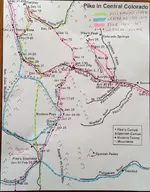sdcfia
Silver Member
The events of the second book took place from 1844-1848. At that time, fifty descendants of the Lebreau Expedition decided to search for the cache of Treasure Mountain. They used maps and notes of the expedition that Lebreau had authored. They traced the route that their grandfathers used, and they split their party, when they were close to Taos, so that the true size of their party would be unknown. At Taos, they hired a guide to take them into the mountains to the north and they let the word spread that they would be trapping. The guide was recommended to them by relatives of Spanish who had befriended the Frenchmen of the first expedition. They spent the next three years searching for the locations of two caches. The search involved looking for multiple clues as well as deciphering written instructions from Lebreau. The clues included symbols carved on trees and rocks and fake graves. They eventually found the caches, one was buried by an outcropping and the other was buried below the surface of a small pond their grandfathers had created by building a small dike to block the outflow of the original pond. They found all the gold and made preparations to leave the area and go to St. Louis by way of the Santa Fe Trail. Just as they were leaving the valley, their rear guard was attacked by the men of Diego Archuleta, a rancher who suspected the Frenchmen were looking for gold left by the previous expedition. The Frenchmen managed to thwart the attack but lost 15 men and a number of horses and pack animals. To continue their journey, the French had to cache 1000 pounds of gold bars so they could replace the horses they lost with pack animals. They eventually made it to St. Louis and returned to their homes, some in Canada and some in France. Their guide and confident, who helped them conceal their mission, returned to New Mexico. The rancher, Archuleta, had murder charges filed against the guide and had them dropped when the guide told him the location of the main camp.
If this is true, then the Treasure Mountain cache is a moot point, having already been recovered. Question: did Adams say that the 1,000-pound cache hidden on the way out was only a short-time temporary thing, or was it implied that it was left behind and still remains hidden?




